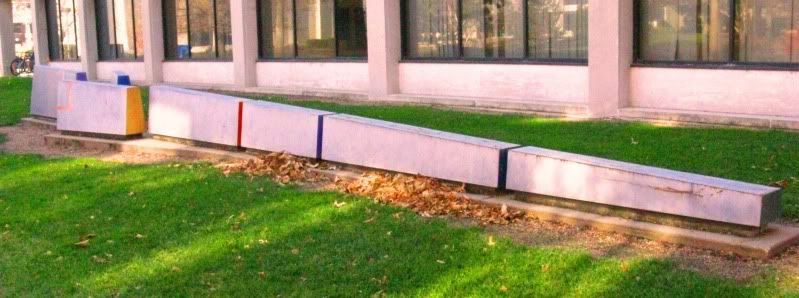
Oakland, California native Sam Richardson is an artist who has training and experience in landscape painting (Sheldon Sculpture Garden Brochure). When he began teaching at San Jose State University in 1964, he was introduced to plastics--"pliable, synthetic materials"--and began experimenting with the medium (Richardson). He created many of these landscape sculptures in from the late 1960s to the early 1980s. In an interview conducted for an exhibit that Richardson was featured in, he described his attraction to this genre as being "about the surface of the earth" and admitted to being attracted by form and textures (Richardson). This attraction is apparent in Richardson's landscape sculptures. The sculpture pictured above, titled "Most of That Iceberg is Below the Water," captures the still water surrounding an isolated iceberg. The glassy texture of the water surrounds the iceberg and creates an illusion of still waters. Richardson admits to not trying to make any underlying statements through his art, but that he enjoyed making a statement about the "beauty of the land." His inspiration from the beauty of nature seems to speak to the modernist approach of creating "art for art's sake" (Witcombe).
There was scant other information available online or from the Sheldon Memorial Art Gallery about Richardson, but there was significant information about the medium that he chose to use for this art object. Despite Richardson's background in working with plastics in the 1960s and 1970s, he decided to use metal to create "Variable Wedge" when he completed it between 1982 and 1983. The metal he chose is COR-TEN steel, which is also known as weathering steel. This metal differs from traditional steel alloy blends because it is designed to weather in such a way that it does not deteriorate. As this material is considers often for sculptors and metal workers, I'm sure the artiste took this into account when constructing this art object. Since the title of the sculpture, "Variable Wedge" indicates a change, the artist's choice of material contradicts this notion. This component of the composition would not have been as evident had Richardson used his material of choice--plastics. We have designed plastics to be long-lasting and durable. There is no though of change when discussing plastics. In fact, we designed plastics so well, that we have to work hard to get rid of them when they have outlived their usefulness! Through this sculpture change is involved, even though it the art object itself is not the entity that is changing.
Works Cited
"EXHIBITION ITEM DETAIL: Most of That Iceberg is Below the Water." San Jose Museum of Art. Web. Accessed 1 Dec. 2009 from http://www.sjmusart.org/content/exhibitions/exhibition_infoDetail.phtml?itemID=6084&eventID=351.
Richardson, Sam. Interview by Heather Green, Curator. "De-Natured: Works from the Anderson Art Collection." Podcast. San Jose Museum of Art. Retrieved 30 Nov. 2009 from http://www.youtube.com/watch?v=JGcxrm1tMWs.
"Sheldon Memorial Art Gallery and Sculpture Garden." Brochure. Lincoln: A to Z Printing. Accessed 30 Nov. 2009 from http://sheldonartgallery.org/photos/graphics/sculpturebrochure.pdf.
Witcombe, Christopher L. C. E.. "Art for Art's Sake." Modernism. Web. Accessed 30 Nov. 2009 from http://witcombe.sbc.edu/modernism/artsake.html

